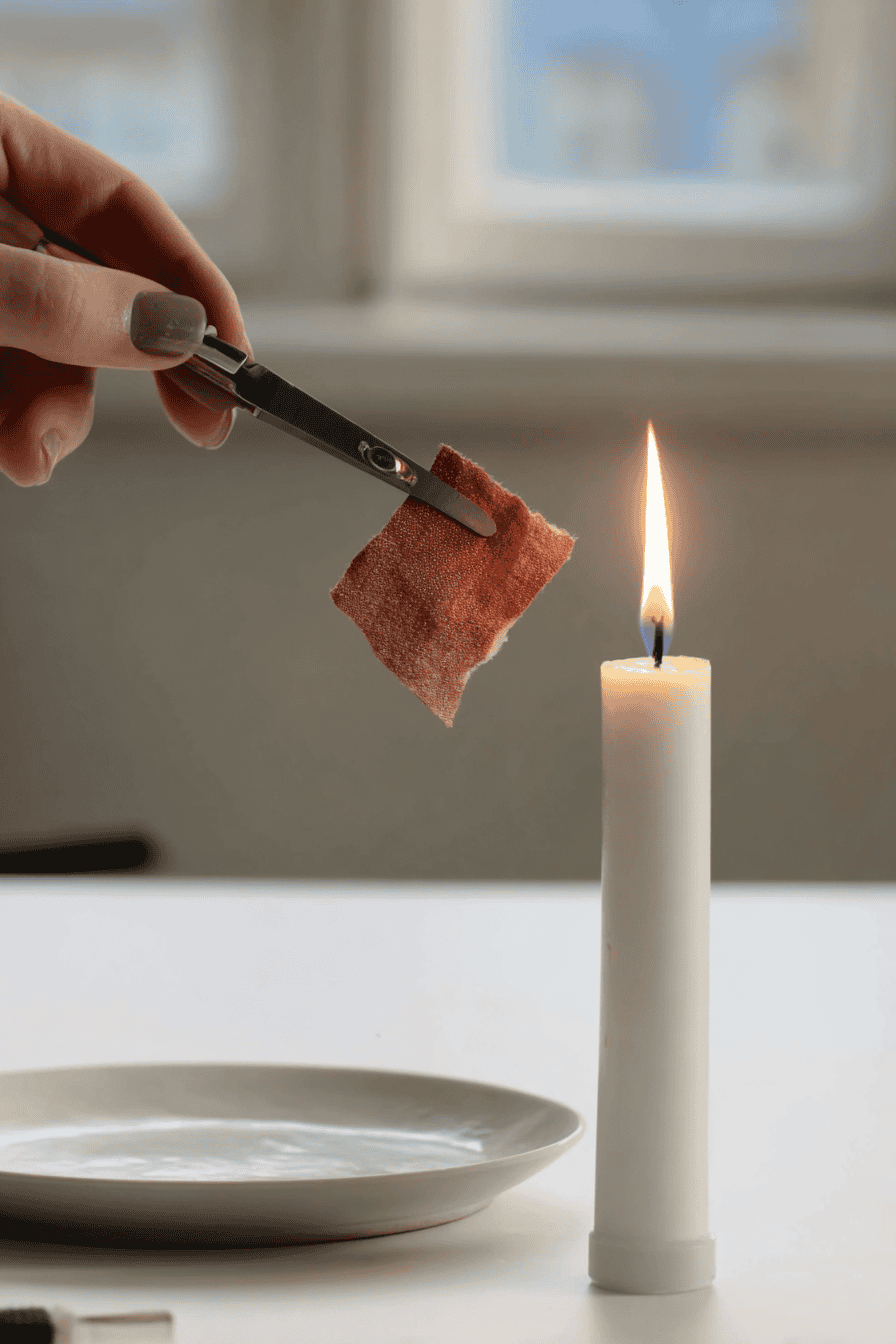There’s a certain ease that comes when you know exactly what you’re working with.
Whether you’re sewing a new apron, mending a favorite shirt, or choosing fabric for a quilt, the materials you use matter.
Natural fibers breathe, age well, and feel right in the hand – but without clear labeling, it’s not always obvious what’s real.
That’s where the fabric burn test comes in. It’s a simple, reliable way to identify what a fabric is made of – right from your own workspace.
In this article, I’ll show you exactly how to perform a burn test safely, what to look for in the flame, and how to read the results like a seasoned maker.
It’s practical knowledge that keeps your hands informed and your choices intentional.
What Is a Fabric Burn Test?
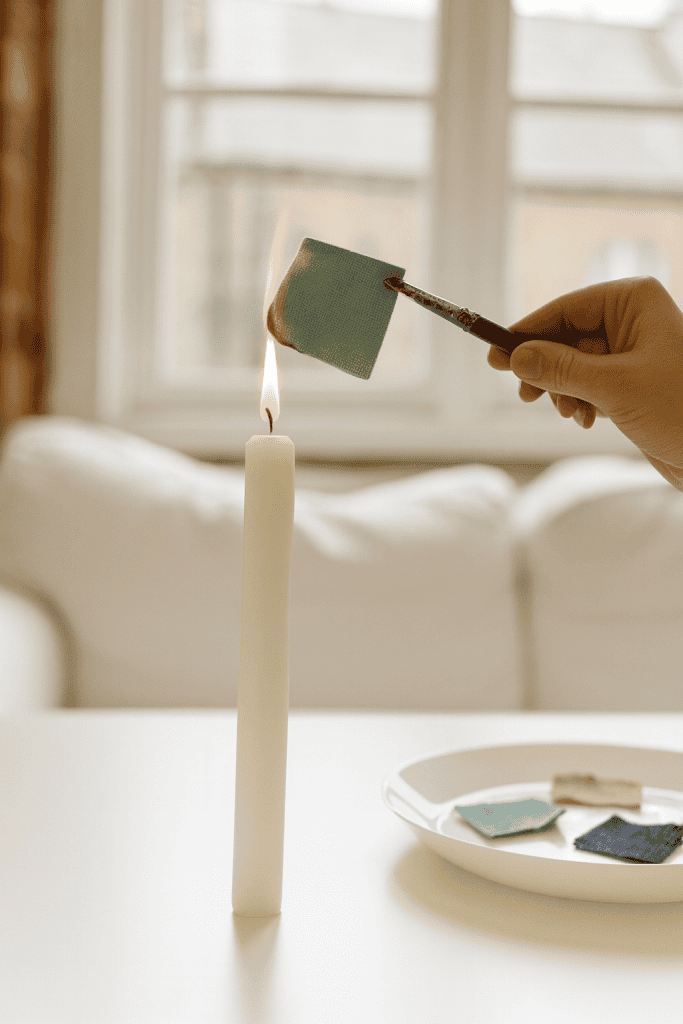
A fabric burn test is a simple way to learn what your fabric is made of – without needing any special equipment.
It works by observing how a small piece of fabric reacts to flame.
Natural fibers like cotton, linen, and wool burn in distinctive ways, while synthetic ones tend to melt or form hard beads.
Each material leaves clues: the smell of the smoke, the shape of the ash, even the color of the flame.
These small details tell you whether your fabric comes from a plant, an animal fiber, or a petroleum-based source.
What makes this test so useful is its clarity. You just need attention and a few seconds of observation.
The burn test helps you make informed choices, especially when fabric labels are missing or unclear.
If you’d rather start by learning how to read fabric labels like a pro, that’s another simple way to understand what your fabric is made of.
Tools for Doing a Fabric Burn Test at Home
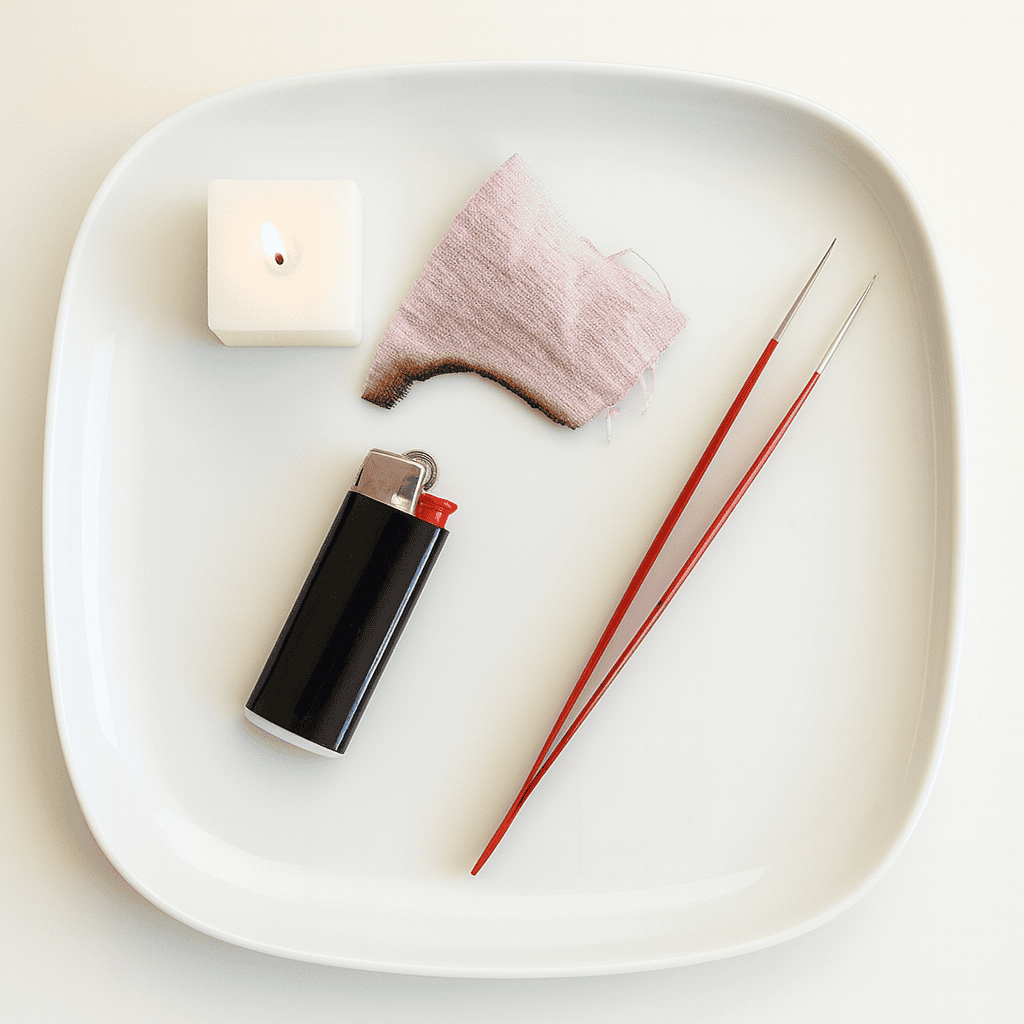
A burn test requires just a few simple tools you likely already have.
Keeping your setup neat and intentional helps you stay focused and confident.
You’ll Need
- Small fabric swatches (cut from your project or a fabric sample)
- A pair of metal tweezers or tongs
- A nonflammable surface such as a ceramic dish or metal tray
- A lighter, candle, or match
- A glass of water or a nearby sink
Arrange everything before you begin.
You’re working with a small flame, not a large fire. Choose a stable surface, avoid drafts, and make sure nothing nearby can catch easily. Good preparation keeps the process steady and calm.
How to Do a Burn Test for Fabric
The burn test is straightforward when done with attention and care.
Each step gives you information – so take your time and notice what happens.
1. Cut a Small Sample
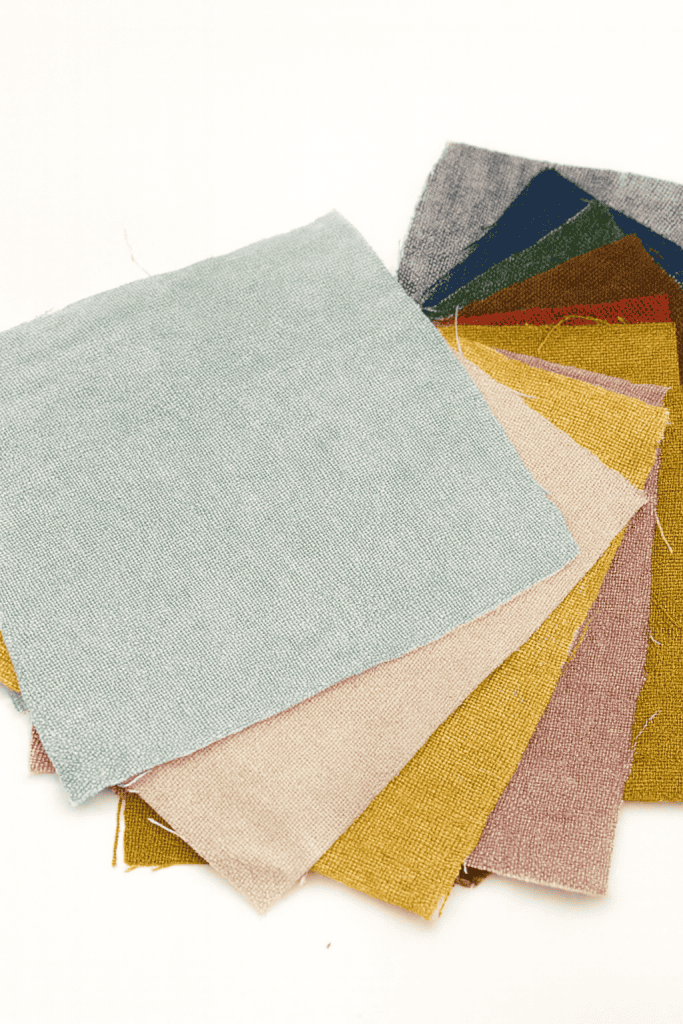
Begin with a small piece of your fabric – about the size of a match head or a pencil eraser. That’s all you need.
Cutting a tiny swatch allows you to stay in control and prevents unnecessary waste.
If your fabric is loosely woven or frays easily, snip from an edge or hidden seam.
2. Hold with Tweezers
Use a pair of metal tweezers or tongs to hold your sample.
This keeps your hands safely away from the flame and allows you to position the fabric precisely.
Hold it lightly but firmly, about an inch above a nonflammable surface like a ceramic dish or metal tray.
A steady grip helps you notice subtler reactions – how the fibers pull, twist, or curl.
These movements are often your first clues about what the fabric is made of.
3. Bring the Fabric Close to the Flame

Move the sample slowly toward the flame rather than pushing it in quickly.
Observe what happens even before contact – some fibers will shrink back from the heat, others will ignite easily.
When it touches the flame, note how it burns:
- Does it catch immediately, or hesitate?
- Is the flame bright and clean, or smoky?
- Does the fabric melt, bead, or turn to ash?
These details tell a lot.
Plant fibers tend to ignite cleanly and burn away to powder. Animal fibers burn slower and give off a hair-like scent.
Synthetics often melt and give a sweet or chemical odor.
4. Observe the Behavior
This is where your curiosity pays off. Watch how the flame travels through the fabric.
A quick, even burn often signals a cellulose (plant-based) fiber.
A self-extinguishing or slow burn usually points to a protein fiber, like wool or silk. Melting or bubbling suggests synthetic content.
The smell is also a reliable indicator. Paper-like, woody, or earthy scents come from plant fibers. A hair or feather smell means animal origin.
Sharp or sweet plastic tones mean synthetics. Trust your senses here – they’re more precise than you think.
5. Check the Ash or Residue
Once the flame is out and the sample cools, examine what remains.
- Soft, gray ash that crumbles easily often means cotton, linen, or hemp.
- Crisp, crushable beads usually signal wool or silk.
- Hard, shiny beads that can’t be crushed indicate synthetic fibers.
Gently touch the residue with your tweezers to test its texture. Even this small detail tells a story about the fiber’s origin.
If you’re testing several fabrics, label each result right away. Over time, you’ll start recognizing patterns – how linen ash looks compared to cotton, or how polyester always leaves a glossy bead.
This practice builds confidence and intuition for every sewing or mending project that follows.
How to Identify Natural vs. Synthetic Fabrics by Burn Results

Once you’ve done a few tests, the differences between fabric types become surprisingly clear.
These cues are consistent and easy to remember once you’ve seen them firsthand.
Burn Test Results for Cotton, Linen, and Hemp (Plant Fibers)
Plant-based fibers like cotton, linen, and hemp share similar reactions because they’re all made of cellulose.
When burned, these fabrics ignite quickly, burn cleanly, and leave behind soft gray ash that crumbles easily between your fingers.
They smell like burning paper or dry wood, which makes sense – cellulose is the same organic material found in plants and trees.
The flame burns bright and steady, without sputtering or melting.
If you’re unsure whether your fabric is pure or blended, this clean, even burn is your best clue.
Natural plant fibers also tend to feel cooler and more breathable in the hand – qualities that make them favorites for home sewing and everyday wear.
Burn Test Results for Wool and Silk (Protein Fibers)
Wool and silk come from animal sources, so their behavior is very different.
They burn slowly, often curling away from the flame, and self-extinguish once removed from heat.
You’ll notice a distinct smell of burning hair or feathers – a reliable sign of protein fibers.
The residue forms a small, crisp bead or ash that crushes easily when pressed.
Wool especially may produce a faint sparkle in the flame as it burns, while silk tends to shrivel into a thin, charred edge.
Both results confirm authenticity and remind you of their natural resilience – fibers designed by nature to protect.
Burn Test Results for Polyester, Nylon, and Acrylic (Synthetic Fibers)
Synthetic fibers behave very differently because they’re made from petroleum-based materials.
When exposed to flame, they melt before they burn and often drip or form hard beads.
The flame may sputter slightly, and the smell is distinctly sweet, chemical, or plastic-like.
The residue cools into a shiny, hard bead that cannot be crushed. This melted texture is the most telling sign of a synthetic material.
Even if the fabric feels soft or natural to the touch, this test quickly reveals its true composition.
These fibers are durable but less breathable than natural ones.
Knowing how to recognize them helps you choose consciously – especially when you prefer natural fabrics for comfort, longevity, and sustainability.
How to Recognize Fabric Blends During a Burn Test
Many modern fabrics combine natural and synthetic fibers, so you may see mixed reactions.
For example, a cotton-poly blend might burn quickly but leave behind a hard bead among the ash.
A silk-rayon mix may partly melt while still smelling faintly of hair.
If you notice this, repeat the test with another sample or observe different sections of the fabric.
You’ll begin to see which fiber dominates. In blends, the melted residue or uneven burn usually points to the synthetic portion.
With a bit of practice, you’ll learn to spot blends easily – and make informed choices about how to sew, wash, and care for each one.
Burn Test Comparison Chart (Natural vs. Synthetic Fabrics)
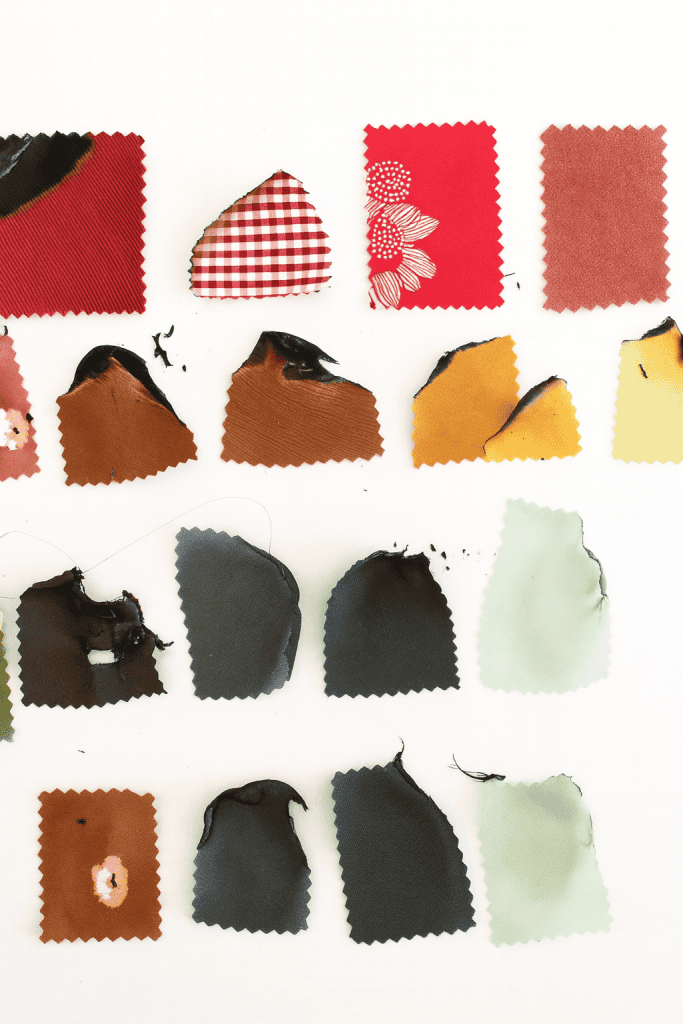
It helps to have a quick reference on hand.
This chart summarizes the key traits you’ll see when testing different fibers – so you can identify them with confidence.
| Fiber Type | Flame Behavior | Smell | Residue / Ash | Natural or Synthetic |
|---|---|---|---|---|
| Cotton | Burns quickly with a bright, steady flame | Paper or wood | Soft, gray ash that crumbles easily | Natural |
| Linen | Burns quickly and evenly | Dry grass or wood | Fine, soft ash | Natural |
| Hemp | Burns steadily with a clean flame | Woody or earthy | Soft gray ash | Natural |
| Wool | Burns slowly, may self-extinguish | Burning hair | Crisp bead that crushes easily | Natural |
| Silk | Burns slowly, edges curl and shrink | Hair or feathers | Small, crushable bead | Natural |
| Rayon / Viscose | Burns like cotton, slightly slower | Paper-like | Soft gray ash | Semi-natural (cellulose-based) |
| Polyester | Melts, may sputter or drip | Sweet, plastic | Hard, shiny bead | Synthetic |
| Nylon | Melts, burns slowly | Celery-like or chemical | Hard, brown bead | Synthetic |
| Acrylic | Melts quickly, sputters | Sharp, chemical | Hard black bead | Synthetic |
| Blends | Combination of burning and melting | Mixed scents | Mix of ash and bead residue | Mixed |
Keep this table nearby when you’re working with unlabeled or vintage fabrics.
Over time, you’ll notice how intuitive it becomes – the flame, scent, and residue all tell a consistent story.
Why the Fabric Burn Test Is Essential for Sustainable Sewing
A burn test is a practical method for sustainable making.
When you know your fabrics, you choose with purpose instead of guessing.
Identifying fibers helps you invest in materials that last, breathe well, and support natural living.
It also reduces waste and prevents disappointment when a fabric doesn’t behave as expected.
In a world of blended and mislabeled textiles, the burn test brings clarity.
It keeps your sewing choices honest, simple, and aligned with your values.
Take This Skill Further: Try a Burn Test Yourself
The best way to remember fabric behavior is to see it firsthand.
Choose a few small scraps from your sewing bin and test them one by one.
Notice the differences, trust what you observe, and keep a small note card of your results.
Each small test sharpens your understanding and strengthens your confidence in what you create.
If you’ve tried this at home, share your results or questions in the comments below – your experience might help another beginner feel ready to start.
FAQs
1. Can I do a burn test on dyed or printed fabrics?
Yes. Most dyes don’t affect the burn behavior, though bright or synthetic dyes may slightly change the smell or smoke color. Focus on the way the base fiber burns, not the colorant.
2. What’s the best way to test fabric blends accurately?
Test from different sections of the fabric. Sometimes one part (like the warp) contains more synthetic fiber than another (like the weft). Consistent results across samples usually reveal the dominant fiber.
3. Can I perform a burn test indoors?
Yes, if your space is ventilated and you’re using small swatches. A ceramic dish or metal tray near a sink works well. Keep windows open or use a range hood for peace of mind.
4. How do I test delicate or expensive fabrics without ruining them?
Cut a thread from a hidden seam or an inside edge. A few loose strands are enough to observe flame, smell, and residue. You never need to sacrifice a visible section.
5. Are there other ways to identify fabric besides burning?
Yes. You can combine the burn test with other checks – like thread count, fabric weave, feel, or water absorption. Each method adds another layer of certainty without relying on labels.

